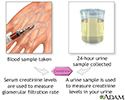Creatinine clearance test
The creatinine clearance test helps provide information about how well the kidneys are working. The test compares the creatinine level in urine with the creatinine level in blood.
How the Test is Performed
This test requires both a urine sample and blood sample . You will collect your urine for 24 hours and then have blood taken. Follow instructions exactly. This ensures accurate results.
Urine sample
The creatinine urine test measures the amount of creatinine in urine. This test is done to see how well your kidneys are working. Creatinine can als...

Blood sample
The creatinine blood test measures the level of creatinine in the blood. This test is done to see how well your kidneys are working. Creatinine can ...

Collect your urine for 24 hours
The urine 24-hour volume test measures the amount of urine produced in a day. The amount of creatinine, protein, and other chemicals released into t...

How to Prepare for the Test
Your health care provider may ask you to temporarily stop any medicines that may affect the test results. These include antibiotics and stomach acid medicines. Be sure to tell your provider about all the medicines you take.
DO NOT stop taking any medicine before talking to your provider.
How the Test will Feel
The urine test involves only normal urination. There is no discomfort.
When the needle is inserted to draw blood, some people feel moderate pain. Others feel only a prick or stinging. Afterward, there may be some throbbing or a slight bruise. This soon goes away.
Why the Test is Performed
Creatinine is a chemical waste product of creatine. Creatine is a chemical the body makes to supply energy, mainly to muscles.
By comparing the creatinine level in urine with the creatinine level in blood , this test estimates the glomerular filtration rate (GFR) . GFR is a measure of how well the kidneys are working, especially the kidneys' filtering units. These filtering units are called glomeruli.
Creatinine level in urine
The creatinine urine test measures the amount of creatinine in urine. This test is done to see how well your kidneys are working. Creatinine can als...

Creatinine level in blood
The creatinine blood test measures the level of creatinine in the blood. This test is done to see how well your kidneys are working. Creatinine can ...

Glomerular filtration rate (GFR)
Glomerular filtration rate (GFR) is a test used to check how well the kidneys are working. Specifically, it estimates how much blood passes through ...
Creatinine is removed, or cleared, from the body entirely by the kidneys. If kidney function is abnormal, creatinine level increases in the blood because less creatinine is released through the urine.
Normal Results
Clearance is often measured as milliliters per minute (mL/min) or milliliters per second (mL/s). Normal values are:
- Male: 97 to 137 mL/min (1.65 to 2.33 mL/s).
- Female: 88 to 128 mL/min (14.96 to 2.18 mL/s).
Normal value ranges may vary slightly among different laboratories. Some labs use different measurements or test different samples. Talk to your doctor about the meaning of your specific test results.
What Abnormal Results Mean
Abnormal results (lower than normal creatinine clearance) may indicate:
-
Kidney problems, such as
damage to the tubule cells
Damage to the tubule cells
Acute tubular necrosis is a kidney disorder involving damage to the tubule cells of the kidneys, which can lead to acute kidney failure.
 ImageRead Article Now Book Mark Article
ImageRead Article Now Book Mark Article -
Kidney failure
Kidney failure
Acute kidney failure is the rapid (less than 2 days) loss of your kidneys' ability to remove waste and help balance fluids and electrolytes in your b...
 ImageRead Article Now Book Mark Article
ImageRead Article Now Book Mark Article - Too little blood flow to the kidneys
-
Damage to the filtering units of the kidneys
Damage to the filtering units of the ki...
Glomerulonephritis is a type of kidney disease in which the part of your kidneys that helps filter waste and fluids from the blood is damaged....
 ImageRead Article Now Book Mark Article
ImageRead Article Now Book Mark Article - Loss of body fluids (dehydration)
- Bladder outlet obstruction
- Heart failure
Risks
Risks of the test involve the blood draw process.
Veins and arteries vary in size from one person to another and from one side of the body to the other. Obtaining a blood sample from some people may be more difficult than from others.
Other risks associated with having blood drawn are slight, but may include:
- Excessive bleeding
- Fainting or feeling lightheaded
- Hematoma (blood accumulating under the skin)
- Infection (a slight risk any time the skin is broken)
References
Inker LA, Fan L, Levey AS. Assessment of renal function. In: Johnson RJ, Feehally J, Floege J, eds. Comprehensive Clinical Nephrology . 5th ed. Philadelphia, PA: Elsevier Saunders; 2015:chap 3.
Landry DW, Bazari H. Approach to the patient with renal disease. In: Goldman L, Schafer AI, eds. Goldman-Cecil Medicine . 25th ed. Philadelphia, PA: Elsevier Saunders; 2016:chap 114.
McPherson RA, Ben-Ezra J. Basic examination of urine. In: McPherson RA, Pincus MR, eds. Henry's Clinical Diagnosis and Management by Laboratory Methods . 22nd ed. Philadelphia, PA: Elsevier Saunders; 2011:chap 28.
-
Creatinine tests - illustration
A measurement of the serum creatinine level is often used to evaluate kidney function. Urine creatinine levels can be used as a screening test to evaluate kidney function, or can be part of the creatinine clearance test.
Creatinine tests
illustration
Review Date: 8/29/2015
Reviewed By: Laura J. Martin, MD, MPH, ABIM Board Certified in Internal Medicine and Hospice and Palliative Medicine, Atlanta, GA. Also reviewed by David Zieve, MD, MHA, Isla Ogilvie, PhD, and the A.D.A.M. Editorial team.

